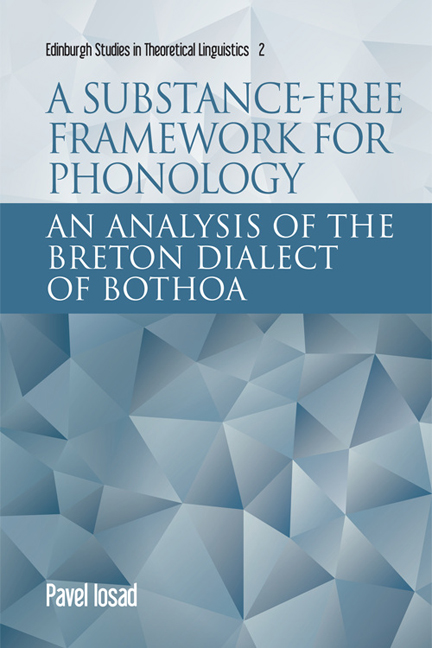Book contents
- Frontmatter
- Contents
- Acknowledgements
- Chapter 1 Introduction
- Chapter 2 Conceptual foundations of substance-free phonology
- Chapter 3 Representational assumptions
- Chapter 4 Computational assumptions
- Chapter 5 Complexity and markedness in substance-free phonology
- Chapter 6 The Breton language
- Chapter 7 Segments and representations
- Chapter 8 Suprasegmental phonology
- Chapter 9 The phonology of vowels
- Chapter 10 The phonology of consonants: palatalisation and gliding
- Chapter 11 Laryngeal phonology
- Chapter 12 Conclusion
- References
- Index
Chapter 4 - Computational assumptions
Published online by Cambridge University Press: 20 December 2017
- Frontmatter
- Contents
- Acknowledgements
- Chapter 1 Introduction
- Chapter 2 Conceptual foundations of substance-free phonology
- Chapter 3 Representational assumptions
- Chapter 4 Computational assumptions
- Chapter 5 Complexity and markedness in substance-free phonology
- Chapter 6 The Breton language
- Chapter 7 Segments and representations
- Chapter 8 Suprasegmental phonology
- Chapter 9 The phonology of vowels
- Chapter 10 The phonology of consonants: palatalisation and gliding
- Chapter 11 Laryngeal phonology
- Chapter 12 Conclusion
- References
- Index
Summary
Although the present book mostly focuses on highlighting the role of phonological representations in accounting for cross-linguistic variation, it is also important to recognise the power of phonological computation. Representations alone are not sufficient either to provide an explicit analysis or, more importantly, to establish the falsifiability of the proposal. In this chapter I describe some general properties of the computational system in substance-free phonology, provide some discussion of constraint schemata and in particular the augmentation schema, and conclude by sketching the stratal approach I use to account for morphology– phonology interactions.
The power of computation
As discussed in Chapter 2, computation is free to manipulate the representations fed into the phonological module in a manner unconstrained by non-phonological considerations. It can ensure that certain surface structures or input–output mappings are excluded from the phonological grammar.
In Optimality Theory, the postulate of Richness of the Base (Prince and Smolensky 1993; McCarthy 2005) makes it possible to derive differences among inventories solely by computational means, i.e. by the reranking of the universal constraint set Con (e.g. Kirchner 1997; Flemming 2005). This has contributed to another swing of Anderson's (1985) representation/ computation pendulum towards a more or less explicit assumption that phonological representations are trivial. In other words, in many OT approaches representation does not play any explanatory role in accounting for cross-linguistic variation in sound patterns (as Scheer 2010: 385 puts it, it has no ‘sovereign arbitral award’).
In a substance-free theory, the language-specificity and learned character of the interface between phonetics and phonology precludes such a total computational reorientation. However, the substance-free approach also recognises the importance of computation, in contrast to declarative formalisms (e.g. Bird and Klein 1994; Bird 1995; Scobbie et al. 1996; Scobbie 1997; Coleman 1998; Lodge 2009), where computation boils down to the very simple unification procedure, with no cross-linguistic variation. Phonology, in the substance-free view, has both a ‘semantics’ (Pierrehumbert 1990) and a ‘syntax’ (Blaho 2008), and both can vary non-trivially across languages.
In this book I use a stratal version of a fairly orthodox variety of Optimality Theory (with a substance-free twist in Con). Specifically, I use a correspondence rather than containment approach to input–output faithfulness (i.e. Max and Dep rather than Parse and Fill).
- Type
- Chapter
- Information
- A Substance-free Framework for PhonologyAn Analysis of the Breton Dialect of Bothoa, pp. 45 - 60Publisher: Edinburgh University PressPrint publication year: 2017



